The Archaeology of Plastic Pollution
Kimberly J. Wooten, Archaeologist, Cultural Studies Office, California Department of Transportation
July 1st marks the beginning of Plastic Free July, a month focused on encouraging the public to actively participate in reducing their daily plastic footprint. These personal actions help reduce our carbon footprint at the same time, as plastic is – in the most basic terms – a petroleum biproduct. In addition, plastic production is currently one of the fastest growing industrial contributors to climate change. In 2021, 300 million pounds of plastic was produced globally, with the amount of plastic waste entering our ocean systems jumping from 8 million tons in 2018 to 14 million tons in 2021 (IUCN 2018, 2021). Much of this plastic pollution comes in the form of single-use plastic packing. Single-use plastics are not generally the consumer’s intended purchase, but simply the packing that hold the real product, including items such as food wrappers, condiment packets, straws, plastic bottles, grocery bags, etc. Single-use plastic products also include plastic utensils, take-out boxes, to-go cups, and other items that make our lives seemingly more convenient but contribute to overflowing landfills. This change in plastic use is something we can strive for in our personal lives, as well as in our professional ones, where archaeological labs are filled with a variety of plastic items, including baggies, containers, pipettes, petri dishes, etc.
Once discarded, this overwhelming abundance of plastic waste potentially enters our global oceans by traveling from terrestrial locations, inadvertently washing down rivers and coastal locations. This same waste washes back ashore, cluttering remote beaches and creating masses of plastic pollution that interfere with marine life, habitats, and impact archaeological sites. These waste landscapes are made worse with the knowledge that only 10% of the plastic entering the oceans remains buoyant – shifting between shore and sea – with the remaining waste sinking below the surface. A relatively new term is being used in regard to international refuse management: waste colonialism. Penned by journalist Ruth Michaelson (2021), waste colonialism describes the process of consuming nations sending their waste to nations that often don’t have the processing capacity or infrastructure to handle the volume or content, creating dire refuse conditions in the recipient country. The material culture of plastic waste, with its limited reuse and long-term viability in the environment in terms of hundreds of years, is also the main contributor to waste colonialism. Even more insidious, as this plastic pollution enters the environment, it breaks down into microplastics that are small enough to be found in rain and snow, growing in plants, and even within the human body (Parker 2022) (Figure 1).
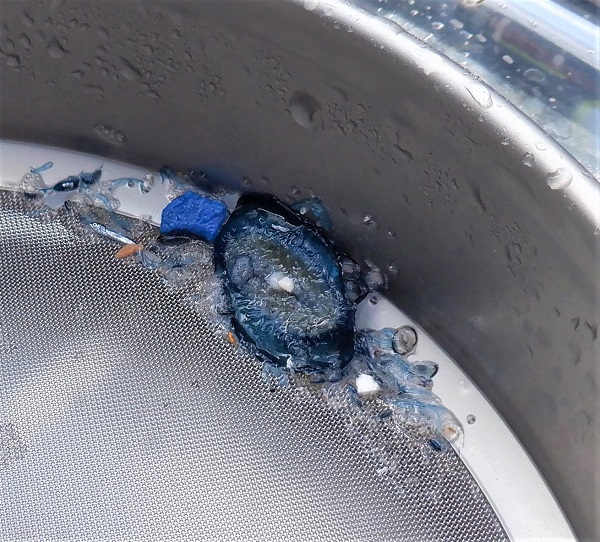
Figure 1. Microplastic sample from the North Atlantic containing a bright blue hydrozoan Velella velella with plastic embedded in its body. (Photo by author, 2019.)
That is a lot of plastic waste – or another way to think about it – a lot of archaeology. I am both an archaeologist and an environmental activist, advocating for the use of archaeology as a platform for raising public awareness about climate change, including the global plastic pollution crisis. At the same time, I recognize that plastic is a creating a monumental shift material culture, delineating the Anthropocene Era with new maritime and terrestrial archaeological deposits globally. From this perspective, it is difficult not to see plastic pollution as an issue to be explored and studied through contemporary archaeology.
In the beginning of October 2019, I set sail with 13 other women on a two-week, 1600 nautical mile journey to study microplastics in the world’s oceans (Figure 2). Microplastics are decayed and fragmented plastic from larger objects – plastic bottles, oil drums, fishing nets, food packaging waste – generally measuring less than 5 millimeters across. As with intact plastics, microplastics can be found in both in the ocean and on land, often sifting down into the stratigraphic layers of water and soil. On occasion the product itself is small enough to be considered a microplastic, as with nurdles (see Figure 3). Weather permitting, microplastic samples were collected daily, and women from multiple nations and professions learned about plastic pollution, advocacy and activism, data collection, analysis, along with open ocean sailing skills.
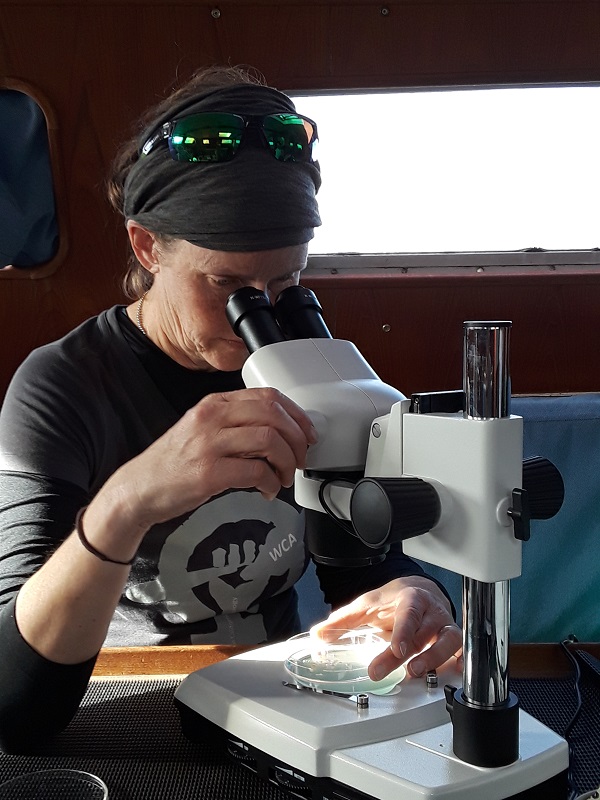
Figure 2. Onboard the S.V. TravelEdge, the author conducts data analysis on samples taken from the North Atlantic Gyre, some 900 nautical miles off the coast of Portugal. (Photo courtesy of eXXpedition, 2019.)
As Valerie Hall wrote in the very first Heritage at Risk Committee (HARC) blog in 2018 “… HARC’s key goals include increasing advocacy efforts at the national and international levels, promoting expansion of heritage at risk themes at the annual conference, and increasing collaboration both with other committees within SHA and with professionals outside of the membership who study the impacts of climate change on our shared cultural resources.” The Heritage at Risk Committee has focused on the impacts of the climate crisis on archaeological resources ranging from coastal erosion and sea level rise, to damage to archaeological collections from hurricanes and wildfires. The committee looks at current and projected impacts to heritage sites, the methodologies to understand these growing impacts, and heritage monitoring to mitigate damages. Part of those climate impacts going forward may include adapting archaeological methods to understand changes in material culture, if not in form itself, then in the fabrication to plastic.
There have been multiple archaeological studies of contemporary waste, including both purchase and disposal patterns, with the most well-known being William Rathje’s (2002) Tucson Garbage Project. Other archaeological studies include material culture patterning of park litter, unsheltered camps, landfills, Burning Man city layout and refuse, and foreshore litter. Some studies have practical applications, including several campus litter studies which are used both to understand litter deposition and for teaching archaeological methods to students. Other studies use apps to crowd source and record plastic refuse data in ways that mirror archaeological survey. All these studies include plastic refuse by the nature of their post-1950s archaeology, after which plastic became much more common. Beginning with the Covid pandemic in 2020, archaeologists began recording pandemic-related waste, including categories for face masks, many of which are single-use plastic-based products (Figure 3).
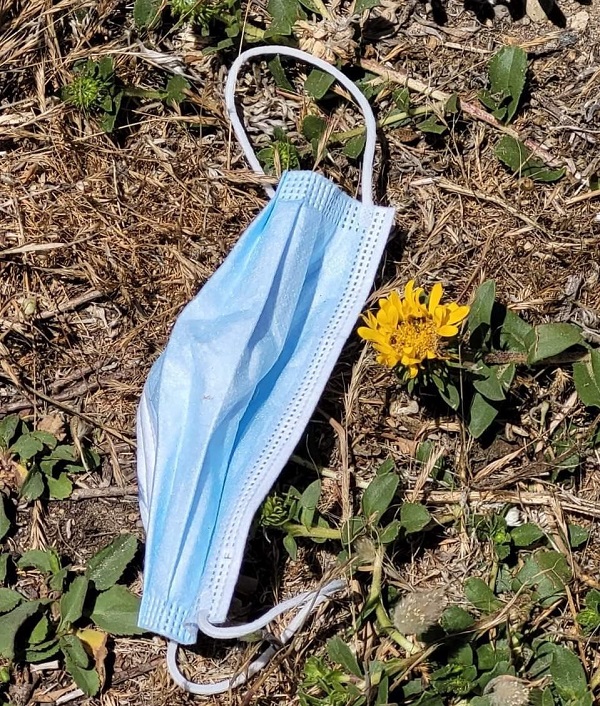
Figure 3. Plastic-based single-use mask discarded at Point Reyes, California. (Photo by author, 2021.)
In contrast, few studies have been conducted with the specific intention of using traditional archaeological methodologies to examine the impacts of plastic waste on heritage sites. Harold Mytum and James Meek (2021) conducted excavations at Castell Henllys, an Iron Age site in Wales, specifically to look at plastic waste. They divided the fort’s two reconstructed roundhouses into quadrants and focused on known activity areas of modern school children. While the roundhouses were experimental reconstructions, the excavations employed traditional methodologies, and the data collected and processed in a way that way both applicable to a known toolkit of archaeological techniques. In populated areas, such as highway corridors and urban neighborhoods, modern refuse often intrudes upon archaeological deposits and plastic waste is commonly noted on site records and during excavations as disturbance. Future studies of archaeological sites may move beyond this simple notation to include analysis of soils samples to see the depths to which microplastics have migrated into site soils (Figure 4).
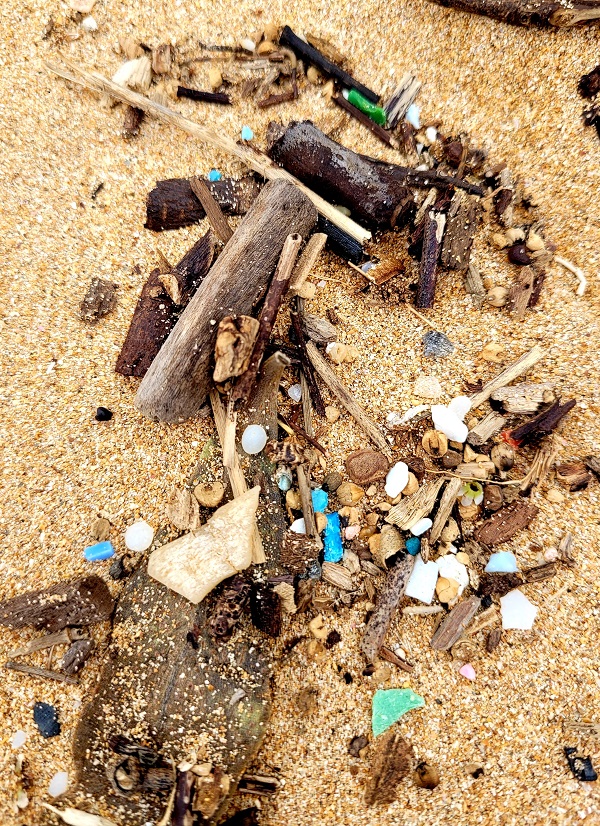
Figure 4. Microplastics, including nurdles, along the wrack line of Keālia Beach in Kauai, Hawaii. (Photo by author, 2022.)
Earlier this year, the United Nations signed an historic agreement to control plastic pollution (United Nations 2022). The End Plastic Pollution: Towards an International Legally Binding Instrument resolution was endorsed by 175 member nations. The treaty’s language is directed at both single-use and microplastic pollution, looking at new ways to approach plastic waste, such as circular economies and sustainable consumption. In the United State, California passed Senate Bill 54 – Solid Waste: reporting, packaging, and plastic food service ware – on June 30, 2022. This bill provides the strongest plastic pollution legislation in the nation, requiring all single-use packaging to be either compostable or recyclable by 2032 (https://leginfo.legislature.ca.gov/faces/billTextClient.xhtml?bill_id=202120220SB54).
Plastic pollution – including single-use plastics, discarded plastic products, and microplastics – negatively impacts terrestrial and maritime heritage resources. Going forward, it is important that historical and contemporary archaeologists develop a methodology to understand the and impacts of plastic waste to archaeological resources. Part of that discussion needs to be the methodologies and artifact typology to record plastic refuse. Ideally, this methodology needs to include a public outreach component that advocates for climate change and tangible plastic pollution solutions. With our hands directly on the material culture of plastic and our understanding of historical consumer behaviors of purchase, use, reuse, and disposal, who better to discuss the translation of these behaviors to the public?
If you would like to participate in Plastic Free July, visit https://www.plasticfreejuly.org. Other online resources for increasing plastic pollution awareness and tools to combat it include the Story of Stuff (https://www.storyofstuff.org/) and Beyond Plastics (https://www.beyondplastics.org/).To discuss plastics in an archaeological context further, please feel free to reach out to the author at kimberly.wooten@dot.ca.gov.
References:
International Union for Conservation of Nature (IUCN)
2018 Issues Brief: Marine Plastics. Gland Switzerland. <https://www.iucn.org/sites/dev/files/marine_plastics_issues_brief_final_0.pdf>.
2021 Issues Brief: Marine Plastics. Gland Switzerland. < https://www.iucn.org/resources/issues-briefs/marine-plastic-pollution>.
Michaelson, Ruth
2021 ‘Waste colonialism’: world grapples with west’s unwanted plastic. The Guardian. < https://www.theguardian.com/environment/2021/dec/31/waste-colonialism-countries-grapple-with-wests-unwanted-plastic>.
Mytum, Harold, and James Meek
2021 The Iron Age in the Plastic Age: Anthropocene Signatures at Castell Henllys. Antiquity 95(379):198-214.
Parker, Laura
2022 Microplastics are in our bodies. How much do they harm us? National Geographic. < https://www.nationalgeographic.com/environment/article/microplastics-are-in-our-bodies-how-much-do-they-harm-us>.
Rathje, William L.
2002 Garbology: The Archaeology of Fresh Garbage. In Public Benefits of Archaeology, Barbara J. Little, editor, pp. 85-100. University Press of Florida, Gainesville, FL.
United Nations
2022a Nations sign up to end global scourge of plastic pollution. UN News.
< https://news.un.org/en/story/2022/03/1113142>.
Upcoming publications include:
Kimberly J. Wooten
2022 Global Impacts: Citizen Science and the Archaeology of Ocean Plastics. Citizen Science in Maritime Archaeology. University of Florida Press, Gainesville, FL.
2023 The Shape of Things: Archaeology, Environmentalism, and Plastic. Historical Archaeology. In review.
SHA Special Publication and Author Perspective
Ships’ Graveyards: Abandoned Watercraft and the Archaeological Site Formation Process
April 5, 2022
Submitted by Mary L. Maniery
PAR Environmental Services, Inc., President
SHA Co-Publications Associate Editor
In March 2018, the SHA began a blog for the Society webpage to highlight our publications and our collaboration with various presses. While our co-publication program and partnerships with Springer, University of Nebraska Press, University of Florida Press, and University of Alabama Press expands our membership’s publication opportunities, the SHA has also continued to publish works independently through Amazon as Special Publications. SHA members can order “Ships Graveyards: Abandoned Watercraft and the Archaeological Site Formation Process” for $22.00 (paperback) or $11.00 (e-book).
Paperback: https://www.amazon.com/Ships-Graveyards-Abandoned-Watercraft-Archaeological/dp/1957402008/ref=tmm_pap_swatch_0?_encoding=UTF8&qid=&sr=
e–book: https://www.amazon.com/Ships-Graveyards-Abandoned-Watercraft-Archaeological-ebook/dp/B09SWN498M/ref=sr_1_1?crid=38WD7BG5XZG92&keywords=ships+graveyard+richards+ebook&qid=1650311082&s=books&sprefix=ships+graveyards+richards+ebook%2Cstripbooks%2C45&sr=1-1
If you are interested in contributing to a joint SHA published volume, please contact SHA’s Co-Publications Editor, Benjamin Ford (ben.ford@iup.edu)
ABOUT THE BOOK
Ships’ Graveyards: Abandoned Watercraft and the Archaeological Site Formation Process
Nathan Richards
Number of pages: 304; 15 tables; 50 figures
Society for Historical Archaeology Special Publication
Ships graveyards was originally published in 2008 as an SHA/University of Florida Press Co-Publication. The 2022 publication is a Second Edition, published solely by the SHA.
Ships’ Graveyards is an explicitly theoretical study that avoids the single-site bias prevalent in most underwater archaeology research. It also eschews the traditional examination of shipwreck sites as the core component of study in this field.
Instead, Nathan Richards seeks to discover what we can learn by examining intentionally abandoned vessels and to determine what the differences are between cultural site formation processes and those created “naturally” (that is, by shipwrecks and other nautical disasters).
Using Australian waters as a case study, Richards examines over 1,500 vessels abandoned over a period of more than 200 years. In offering such a detailed focus on an underutilized archaeological resource, he provides a model for the examination of similar sites and processes in many other locations around the world.
AUTHOR INTERVIEW
MM: What are some of your motivations for writing/spearheading this book?
NR: This is the 2nd edition of the work. The book was derived from my PhD dissertation (Flinders University, PhD in Archaeology, 2002). I was lucky enough to have my adviser (Dr. Mark Staniforth) submit it to SHA for consideration as a part of the dissertation prize (now called the Kathleen Kirk Gilmore Dissertation Award), and I was honored to win the award in 2003 (presented in 2004). The award came with a contract with University Press of Florida, which co-published the 1st edition with SHA in 2008. Through my work at Flinders University I became very interested in the application of processual comparative approaches to maritime archaeological subjects (also thanks to Professor Donald Pate, here) as I was exposed to ship abandonment areas scattered around the coastlines of Australia. This is an ongoing interest of mine, and I’ve been lucky to work on similar sites across the USA, and in Bermuda and Costa Rica.
MM: Who would you like to read this book? Who is your audience?
NR: In 2008, I was hoping the book would provide a theoretically-explicit perspective for looking at maritime archaeological data, and to help continue the development of the study of ship graveyards and to glean insights from watercraft discard behaviors. In 2013, I was fortunate to co-edit a book with Sami Seeb that highlighted some of the perspectives of scholars in this area (as The Archaeology of Watercraft Abandonment, Springer Press). In 2022, I still feel I have the same motivations, but I think I’ve become more interested in communicating how behavioral archaeological approaches continue to have relevance and application to maritime archaeological subjects. Realizing ship abandonment is very much a niche subject, I’d hope the audience would include a broad cross-section of maritime researchers, from students and avocational audiences to heritage managers and academics.
MM: Now that you have published this book, what kinds of things are you dreaming up next? What is in the works?
NR: As an adherent to Michael B. Schiffer’s work, I am interested in research themes that run the length and breadth of the subjects he wrote about over many decades regarding archaeological site formation and technological innovation and change – but adapted to the maritime domain. I have partial manuscripts concerned with the use-lives of individual vessels and fleets (wrecked and abandoned watercraft) to themes of technological adaptation and human agency. The sites range from fleets of abandoned barges run aground in the Caribbean, ferrous-hulled shipwrecks lost in locations like Hawai’i, and amphibious landing craft in the sounds of North Carolina. I just need to find the time to finish one!
Thanks to SHA for the opportunity to publish a 2nd edition of the work.
Virginia’s Inland Waters Heritage Risk Assessment and Survey
by Elizabeth A. Moore (Virginia Department of Historic Resources)
Location: Multiple Rivers in Virginia
Problem: Virginia has 64 rivers, river branches, major creeks, and runs totaling 2,452 linear miles and is home to 3,285 square miles of submerged lands that represent 7.7% of the state. Inland waterways are being impacted by elevated storm frequency and intensity that results in increased erosion, flooding, and damage to natural and cultural resources. In 2018, Hurricanes Michael and Florence took an inland path in Virginia, impacting 52 counties and cities. It became clear that DHR does not have sufficient survey data for archaeological resources in and adjacent to our waterways to assess threats and mitigate further storm damage. Survey of historic resources in and along some of Virginia’s rivers was conducted in the 1990s and early 2000s, and was published in a series of River Atlases by the Virginia Canals & Navigation Society (VC&NS). Revisions have been made to some of the volumes since then, but no systematic survey has been completed to examine previously undocumented areas or to update the condition of known sites.
Project Description: This assessment and survey effort will examine approximately 157 miles of sections on the Smith, Rappahannock, Dan, Banister, Appomattox, Rivanna, James, and New Rivers. This work has been divided into a series of survey efforts to be conducted by qualified consultants. These surveys will identify, document, and reassess storm impacts to cultural resources along riparian zones in portions of the Coastal Plain, Piedmont, and Mountain and Valley areas. Prior to fieldwork, survey teams will examine existing site data, paying particular attention to the information in the VC&NS River Atlases and accompanying photographic documentation of site conditions. LiDAR data analysis of a 200 meter swath on either side of waterway banklines will identify landforms consistent with cultural materials. Those features will be cross referenced against historical documentation, maps, and informant interviews. Contact will be made with key stakeholders including federally and state recognized Tribes, local government staff, residents, and local recreation and conservation groups. Fieldwork will consist of staff visual examination of riparian zones via small craft. This work is supported with a grant from the National Park Service’s Emergency Supplemental Historic Preservation Fund managed by the State, Tribal, and Local Plans and Grants Division.
Impacts: Long term impacts to sites in and on Virginia’s waterways include destruction and loss of ruins and standing historic structures (mills, dams, bridges, etc.); erosion and potential loss of sites on riverbanks and floodplains; damage to and loss of numerous submerged sites such as fish weirs and channels; and site burial from siltation.
Action: Acquiring and analyzing survey and assessment data is only the beginning of mitigating potential damage from increased storm activity. That assessment must be used to prioritize documentation and data recovery efforts before sites are lost. Three of the survey projects have been contracted, and tribal consultation and fieldwork has been completed. Results from the first of these projects on the Banister River in Pittsylvania County have been submitted to DHR. In a 20 mile stretch of the river, 23 archaeological sites were documented, 22 of them previously unrecorded. These sites include wing dams, dams, historic erosion control walls, bridge abutments, a mill, and a possible sluice. Nine fish weirs were documented, only one of which was previously recorded.
This project surveys only a fraction of Virginia’s inland waterways; models must be developed to prioritize additional survey areas. Strategies to mitigate data loss including erosion control or resource documentation and data collection must be developed and implemented. Engaging the public has proven to be critical to successful fieldwork. Local residents not only know the easiest and safest ways to access the rivers, but are often knowledgeable about historic resources in the water and on the riverbanks. Recreation and conservation groups value natural and cultural resources and these groups can be important partners in further site documentation and preservation.
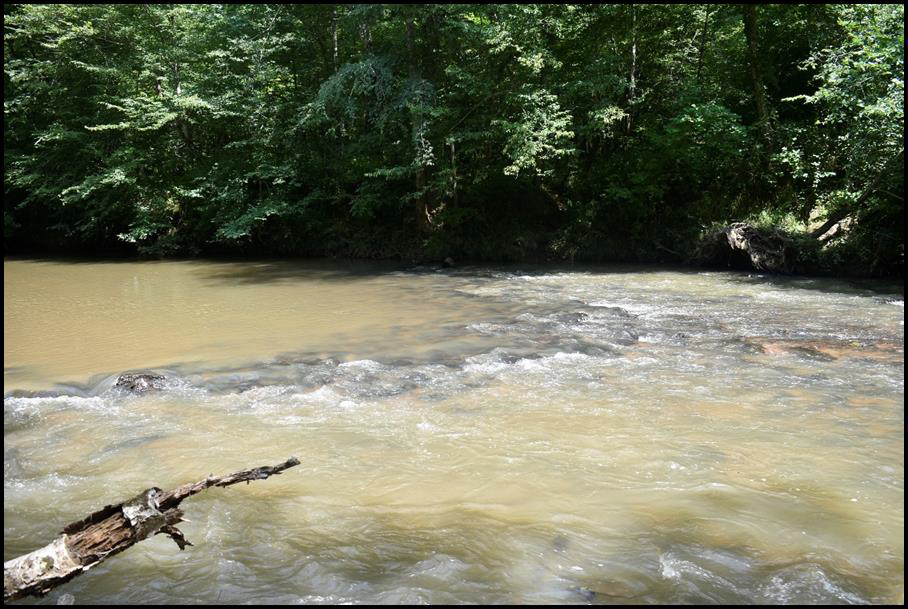
44PY0529, fish weir, looking north. Photo by Dwayne Pickett, Hurt & Proffitt.
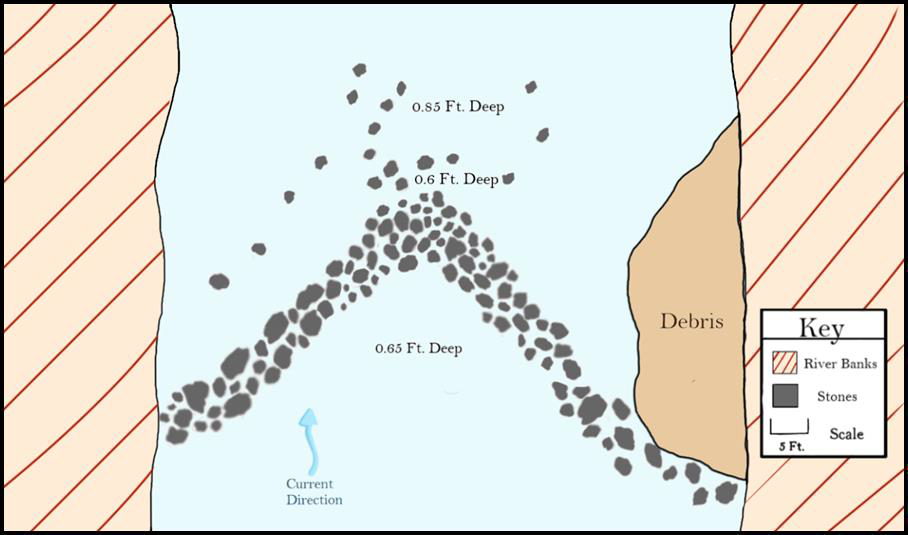
44PY0529, fish weir, plan view. Water level at USGS gauge 02077000 4.22 feet.
Erosion gully along the right bank next to site 44PY0529 looking south. Photo by Dwayne Pickett, Hurt & Proffitt.
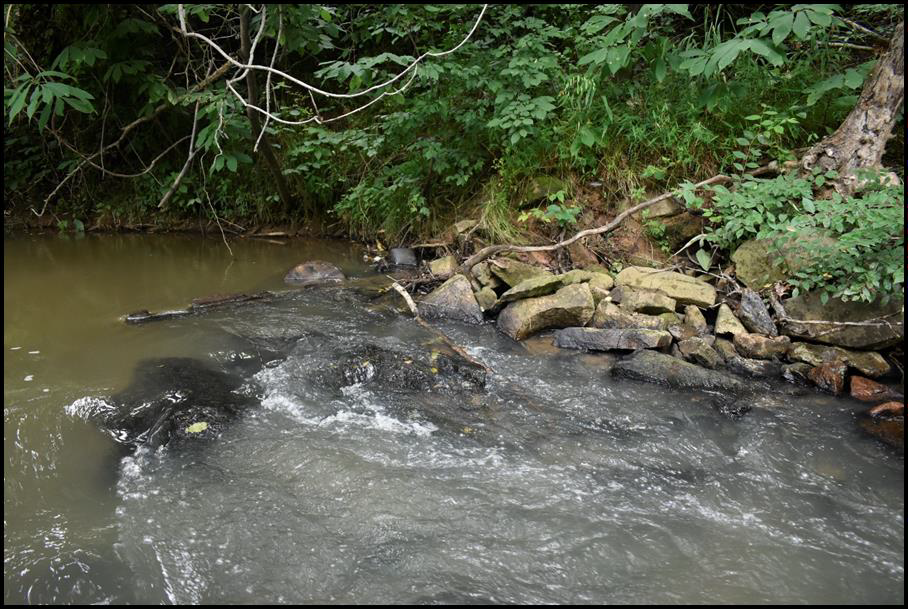
Site 44PY0537, possible dam remnants, looking northwest. Photo by Dwayne Pickett, Hurt & Proffitt.

Site 44PY0539, bridge abutment, looking south along the right bank. Photo by Dwayne Pickett, Hurt & Proffitt.
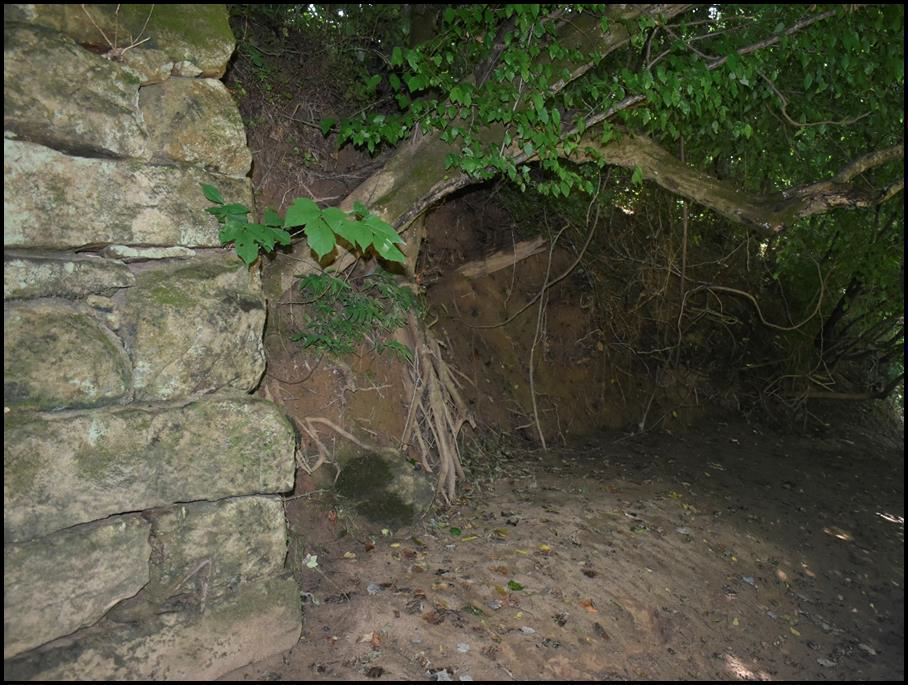
Site 44P0539 showing erosion along left bank looking northeast. Photo by Dwayne Pickett, Hurt & Proffitt.
All graphics are from Archaeological Survey of the Banister River, Pittsylvania County, Virginia. 2021, submitted to the Virginia Department of Historic Resources by Dwayne Pickett, PrincipaI Investigator, Hurt & Proffitt, Inc.
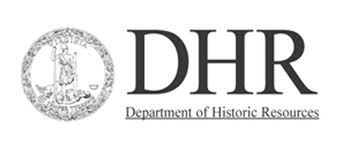

Historical Archaeology volume – Religious Communities, Religious Landscapes
by John M. Chenoweth
Historical archaeologists engage with religion and ideology when excavating sites of worship or burial, but considering how central religion has been to many people over the last few centuries, this facet of human identity has sometimes gotten lost in the shuffle. A recent collection of papers published in Historical Archaeology foregrounds the consideration of religion, even when examining sites and objects that may not seem to invite it. As we have seen in many contexts over the last few decades of historical archaeological work, artifacts often speak to multiple aspects of past life at once: a ceramic plate is more than merely a container for food but can be part of the negotiation of gender, social class, and race as well. Similarly, objects would have often had religious connotations and been used in the active creation of religious communities, putting ideology into practice, and holding many meanings at once.
Entire landscapes are conceived, built, and actively lived in, in part, with religion as a motivating factor. For instance, the collection contains two considerations of how Hawaiian landscapes are structured by very different religions: Native Hawaiian ideology on Maui as some transitioned to Christianity (Baer), and the landscape of the Utah desert, as a group of Hawaiian converts to Mormonism attempted to carve out new lives (Pykles and Reeves). Further, my own contribution (among others) shows how the physical land where a religious group develops can have an influence on the way its ideals are put into practice, using an example from 17th century Barbados’ Quaker community.
The famous (in archaeological theory at least) idea of Hawkes’ Ladder suggested that, while technological and economic aspects of the past may be readily accessible to archaeologists, more ideological ones may be beyond our scope. Yet even the most mundane aspects of human life, such as eating, are frequently imbued with religious motivations: consider the changes of diet accompanying holidays like Lent and Ramadan, for instance. Papers in this collection make the case that religious community and ideology necessarily dovetails with archaeological considerations of nationalism (Horning), race (Blouet, Fennell), and class (Hodge) as each of these intersect. In short, religion also influenced how each of these forces effected past lives, and the collection in Historical Archaeology shows that these connections are not simple or unidirectional, but part of that complex whole that is human cultural life.
SHA Special Publication and Author Perspective – The “Other” Dixwells
Submitted by Mary L. Maniery
PAR Environmental Services, Inc., President
SHA Co-Publications Associate
In March 2018, the SHA began a blog for the Society webpage to highlight our publications and our collaboration with various presses. While our co-publication program and partnerships with Springer, University of Nebraska Press, and University of Florida Press expands our membership’s publication opportunities, the SHA has also continued to publish works independently through Amazon as Special Publications. SHA members can order “The Other Dixwells” for $22.00.
If you are interested in contributing to a joint SHA published volume, please contact SHA’s Co-Publications Editor, Benjamin Ford (ben.ford@iup.edu)
ABOUT THE BOOK
The “Other” Dixwells: Commerce and Conscience in an American Family. (2021)
Thomas N. Layton
Number of pages: 465; 70 figures
Society for Historical Archaeology Special Publications
Who could have imagined that the Chinese opium trade, American feminism, and the abolitionist crusade could be connected, or that an entire branch of a prominent Boston commercial family could have been erased from the historic record for a century-and-a-half, or that a multi-decade saga to restore them to history would begin when archaeology students excavated Chinese potsherds from a Native American archaeological site atop a remote ridge on the north coast of California? Archaeologist Tom Layton follows those potsherds to their origin on the 1850 shipwreck of the Frolic, a clipper brig, owned by American merchants who hauled opium from India to China. Those potsherds lead to George Dixwell—opium expert, inventor, and part owner of the Frolic—and to clues about his marriage in China to Hu Ts’ai-shun, a Manchu woman. Further research leads to the women of Dixwell’s family tree who turned out to be writers and activists—aunt Judith Sargent Murray, the grandmother of American Feminism, and her niece Henrietta Sargent, a fierce abolitionist who reported the first public speech of an escaped slave—Frederick Douglass. Finally the sherds lead Layton to Ts’ai-shun’s four American great-granddaughters who had preserved a trove of letters, photos, and diaries that enabled this story to be told. Layton reveals his scientifically documented archaeological record then dons the hat of a novelist, filling in the spaces among the facts, bringing these characters to life, and producing an unforgettable read—a true adventure revealing the successes, failures, passions, and secrets of a 19th-century American family.
AUTHOR INTERVIEW
MM: What are some of your motivations for writing/spearheading this book?
TL: I wrote The “Other” Dixwells: Commerce and Conscience in an American Family – the third volume of the Frolic Shipwreck Project – to press the envelope of archaeological reporting. In the first two volumes, I had written in a scholarly voice, telling the story of a worldwide system of commerce moderated by the sale of opium to China. In the first, I had told the story of Americans in the opium trade, and in the second I told the story of a wrecked cargo of Chinese manufactured goods bound for Gold Rush San Francisco. But those volumes were focused on the men who had owned and operated the Frolic.
Now I wanted to describe the remarkable women who stood uncomfortably behind those men – fierce abolitionists and women’s rights advocates with careers of their own – and I wanted to present them in an accessible voice as fully formed people living complicated lives.
To accomplish this, I decided to adopt the techniques of a novelist – employing dialogue and character development – judiciously filling in the cracks between the known facts while trying not to extrapolate beyond them. To accomplish this, and to avoid outraging my archaeological colleagues, I wrote a parallel text in the endnotes, listing all my sources and specifying where I had gone beyond them.
In short, I wrote this volume as an experiment in archaeological writing, hoping it would encourage others to explore more creative ways in which to present the results of their archaeological studies.
MM: Who would you like to read this book? Who is your audience?
TL: I have long felt that if the archaeological profession expects to receive continued support from our legislators, we need to write not just for an audience of other archaeologists and university tenure committees, but also for the general reading public. In this book, I attempted to reach both constituencies. Academic publishers have not been kind to those who have attempted to press the envelope of academic convention. This book was rejected by a multitude of academic publishers because it contained a creative non-fiction component. Those rejections even included the Society for Historical Archaeology’s academic press partners for co-published books. I hope that those academic press editors, too, will read this book and create space in the future for new approaches to writing archaeology and history.
MM: Now that you have published this book, what kinds of things are you dreaming up next? What is in the works?
LT: Way back in 1984, when my students excavated Chinese ceramics from an early historic Pomo village site, my first task was to find the shipwreck from which the Pomo had collected them. My next task was to find the wreck divers who had more recently pillaged the wreck and convince them to return their collections for scientific study. I developed rapport with the wreck divers by conducting multiple taped oral history interviews of each of them, and I promised to credit their contributions in my books.
This I did, but the full oral history transcripts were to lie in a cardboard box for decades until, during the forced social isolation of Covid-19, I finally re-read the wreck divers’ narratives together with the related oral histories I had conducted of my archaeological colleagues. I then realized that the awkward story of California wreck divers and their decades of pillage was just as integral to the story of underwater archaeology in California as were the narratives of me and my archaeological colleagues. When I asked Jim Delgado to update his 1992 oral history narrative, he revealed that he had written an unpublished manuscript telling the story of underwater archaeology in California. Jim and I, together with Ben Ford of the Society for Historical Archaeology all agreed that both manuscripts should be published as parts of the same volume, presenting the first-person narrations of California’s underwater pillagers, together with the history of scientific research by maritime archaeologists. This book is now in the works as another SHA Special Publication.
SHA Special Publication and Author Perspective
November 4, 2021
Submitted by Mary L. Maniery
PAR Environmental Services, Inc., President
SHA Co-Publications Associate
In March 2018, the SHA began a blog for the Society webpage to highlight our publications and our collaboration with various presses. While our co-publication program and partnerships with Springer, University of Nebraska Press, and University of Florida Press expands our membership’s publication opportunities, the SHA has also continued to publish works independently through Amazon as Special Publications. SHA members can order “Artifacts that Enlighten” for $24.00.
If you are interested in contributing to a joint SHA published volume, please contact SHA’s Co-Publications Editor, Ben Ford (ben.ford@iup.edu)
ABOUT THE BOOK
Artifacts that Enlighten: The Ordinary and the Unexpected (2020)
Linda Stone, Barbara J. Heath, and Patricia M. Samford, editors
Number of pages: 85
Society for Historical Archaeology Special Publications
Most of the artifacts archaeologists uncover are utilitarian and mundane. However, artifacts are sometimes recovered that provide a surprising narrative or present an interpretive conundrum. The articles in this volume share eleven stories of artifacts that enlighten, presenting artifacts of varying types, locales, and periods with engaging stories that illuminate the ways in which historical archaeologists encounter and interpret the past through material things.
AUTHOR INTERVIEW
MM: What are some of your motivations for writing/spearheading this book?
Linda S: The volume was based on a popular 3-minute format conference session. Both attendees and presenters were enthusiastic about continuing the conversation. That enthusiasm snowballed into this book.
MM: Who would you like to read this book? Who is your audience?
Linda S: The book was written for both professional and lay audiences. Each chapter is short and contains many images, as were the 3-minute conference papers.
Barbara H.: I agree with Linda’s answers. I’d add that the book is also a useful reader for undergraduate archaeology students, and maybe students in museum studies or other object-oriented disciplines.
MM: Now that you have published this book, what kinds of things are you dreaming up next? What is in the works?
Linda S: I’ve got no plans to publish anything, but am always feverishly working on gray literature/CRM reports. I am continuing to do field work on Governors Island and on the lookout for any kiln waste, the subject of my chapter. Should I have updates to the chapter, I would expect to share that information, either in a presentation, posting, or article.
Barbara H: I’ve got two books in the works, one an edited volume on the archaeology of the Potomac River Valley ca. 1550-1720, and the other a co-authored book on the same region and general time period. I’m also hoping to write a book about the use of cowrie shells in North America, but still need to finish up some research on that one.
Patricia S: I am currently in the final editing stages of a co-authored book on the archaeology of Baltimore and in the beginning stages of a co-authored volume on the archaeology of the Chesapeake.
Heritage in the Eye of the Storm—Hurricanes, Coastal Erosion, Sea Level Rise and the State of Coastal & Maritime Archaeology in the North Carolina Coastal Plain
Allyson Ropp
Historic Preservation Archaeological Specialist, NC Office of State Archaeology
Take a second to imagine the colony of North Carolina in 1738 and being in a small town on the Pungo River in North Carolina. This town, called Woodstock, was a small port town off the Pamlico River and served as the county seat of Hyde County. Woodstock was a world unto itself in the swampy landscape of the North Carolina Coastal Plain, with a courthouse, plantations, and wharves bustling with ships and sailors. Where is this town today, as it is probably one you have never heard of?
Woodstock is now buried beneath sediment and water in the Pungo River. It exists only as an archaeological site that has already been subsumed by rising sea level, exposed to coastal erosion, and impacted by hurricanes. It is one of over 5,500 archaeological resources in the thirty-one counties of the North Carolina Coastal Plain that are threatened by rising seas, erosion, intensified storms, and associated storm surge.
The North Carolina Office of State Archaeology (OSA) is tasked with preserving archaeological resources throughout the state, including the over 5,500 at risk in the Coastal Plain. The OSA works to assess and manage the current and future impacts of these environmental threats to archaeological resources. Much work has gone in surveying large swaths of the coastal counties to create an inventory of resources. These surveys documented terrestrial, submerged, and intertidal sites throughout the Coastal Plain. This baseline of information allows managers to grasp the extent of sites in that region of the state.
Since the early 2000s, there have been efforts to understand the types and quantities of sites at risk from sea level rise. This work was refocused with the release of the 4th Assessment Report by the Intergovernmental Panel on Climate Change, which estimated sea level would rise between 0.5 and 2 meters by 2100 (IPCC 2007). In the wake of this assessment, OSA, under the guidance of Lawrence Abbott, undertook the OSA Sea Level Rise Project to provide a baseline estimate of the number of resources to be impacted under the IPCC sea level rise estimate. Abbott assembled data for archaeological resources within 30 feet of the mean sea level across 31 counties in the Coastal Plain. Within this data, he examined their evaluation for the National Register of Historic Places. Only 204 of the 5,700 sites within the project confines had been assessed and deemed eligible, approximately 2,400 were deemed ineligible, and the rest were not evaluated (Abbott 2011). All are at risk.
Now let’s fast forward to the hurricane season of 2018…
Throughout the Atlantic that season, 15 storms were named, 11 of which grew to hurricane strength, and 4 of which made landfall. Two of these named hurricanes directly impacted North Carolina. In early September 2018, Hurricane Florence made landfall near Wrightsville Beach as a Category 1 hurricane. It brought extensive storm surge and considerable rainfall, causing wide-ranging flooding across the southeastern portion of the state and over $22 billion in damages. About a month later, Hurricane Michael struck the Florida Panhandle as a Category 5. It quickly downgraded and moved north, reaching North Carolina the day after making landfall. With it came a deluge of rain to the western and central parts of the state, causing approximately $1 billion in damages in North Carolina alone.
The hurricanes impacted many aspects of life in North Carolina and in surrounding states, from infrastructure to homes to agriculture to people themselves. They also impacted archaeological resources and historic structures. In response to these storms and Typhoon Yutu, the National Park Service issued $47 million in emergency supplemental funding for cultural resource protection and preservation in states and territories impacted by Hurricanes Florence and Michael and Typhoon Yutu. This funding is aimed to finance brick and mortar projects for the restoration and stabilization of historic structures and survey projects to identify and assess impact resources to assist with future storm mitigation.
North Carolina was awarded $17 million of this supplemental fund. For North Carolina, this award is funding 27 projects across counties with FEMA declarations related to the 2018 storms. Two OSA projects are being funded from this award. One of the projects is the Historic Cemetery Survey Project, headed by OSA’s Historic Cemetery Specialist Melissa Timo. This project will assess the condition of historic cemeteries on state lands in nine coastal counties. In addition to assessing the conditions of historical cemeteries, the Cemetery Survey will locate and record cemeteries not documented in the North Carolina Site File and identify discrepancies in the Site File. Since they are underrepresented in state records, a major goal of the Cemetery Survey is to illuminate the histories of African Americans communities and associated unmarked burial grounds and cemeteries. The results of this work will be used to develop site condition monitoring and storm preparedness plans in coordination with the land-managing entities stewarding these places.
The sister project to the Historic Cemetery Survey is the NC Shorescape Survey Project, designed by Assistant State Archaeologist Mary Beth Fitts and Chris Southerly, Deputy State Archaeologist – Underwater. While the Historic Cemetery Survey focuses on historic cemeteries, the Shorescape Survey focuses on archaeological resources in state lands and waters along the shorelines of twelve coastal counties. Employing a thematic approach, this project will combine terrestrial and underwater survey methods to identify underrepresented resource types and create information for stewardship plans, historic contexts, and public education. Of the thematic contexts proposed for study, so far planning efforts have focused on maritime industries and the African American experience in Coastal North Carolina. However, it is expected that a whole range of sites associated with different periods of North Carolina’s history will be recorded 60 meters inland of mean sea level, and 60 meters seaward. .
The focus of work so far has been on conducting a review of existing archaeological site and cemetery data and prioritizing areas for archaeological investigation. I’ve gathered historical records and maps relating to maritime industries, cemeteries and burial practices, and African American communities, and also conducted a geospatial analysis of the impacts of storm surge and flooding on state lands. Combining this information, I mapped areas with storm impacts, previously documented archaeological sites, and locations with high potential for unrecorded historic sites to identify areas of high interest, medium interest, and low interest in anticipation for beginning the surveys.
So what’s next for heritage at risk in Coastal North Carolina??
Well, it isn’t all bleak! These two survey projects are moving forward. The results of these projects will help OSA understand the impacts of storms on archaeological resources and implement management strategies to preserve these resources as best we can. A follow-up study to Abbott’s Sea Level Rise project is also underway in light of the most recent IPCC study and the documentation of more archaeological resources since 2011.
To learn more about our project, follow OSA on Facebook (North Carolina Office of State Archaeology), on Twitter (@ncarchaeology), on our blog (All Blogs | NC DNCR Office of State Archaeology (ncdcr.gov))., and tune into the Submerged NC Webinar series (Submerged NC Webinar Series | Monitor National Marine Sanctuary (noaa.gov).
Citations
Abbott, Lawrence E, Jr.
2011 The Office of State Archaeology Sea Level Rise Project: Initial Results and Recommendations Concerning the Adaptation of Cultural Resources to Climate Change. White Paper. Presented to the Department of Cultural Resources Regarding the Potential Effects of Sea Level Rise on Archaeological Sites in the Coastal Plain of North Carolina. Office of State Archaeology, Raleigh, NC.
Intergovernmental Panel on Climate Change (IPCC)
2007 Climate Change 2007: The Physical Science Basis. Contribution of Working Group 1 to the Fourth Assessment. Report of the Intergovernmental Panel on Climate Change, S. Soloman, D. Manning, Z. Chen, M. Marquis, K. B. Averyt, M. Tignor, and H. L. Miller (editors). Cambridge University Press, Cambridge.
A Summary of the Past Presidents’ Student Reception on Careers in Museums and Collections
Society for Historical Archaeology 2021 Virtual Conference
By Julia A. King, Patricia Samford, and Mark Warner
During the Society for Historical Archaeology’s (SHA) 2021 Virtual Conference, the SHA held six “virtual” Past Presidents’ Student Receptions over several days. During these sessions, which were each an hour long, students were able to engage SHA’s leaders in conversation and explore a wide range of career paths in historical archaeology.
The following is a summary of the discussions from the session on Museums and Collections. The panelists for this session were Julia A. King, Patricia Samford, and Mark Warner.
- Julia A. King is professor and chair of anthropology at St. Mary’s College of Maryland. King received her B.A. degree from William and Mary, her M.A. degree from Florida State University, and her Ph.D. from the University of Pennsylvania. She was the founding director of the Maryland Archaeological Conservation Laboratory and has written about archaeological collections management. She is a past president of the Society for Historical Archaeology and served as the first Expert Member in archaeology on the Advisory Council on Historic Preservation. In 2018, King received the J. C. Harrington Award from the SHA.
- Patricia Samford is the director of the Maryland Archaeological Conservation Laboratory in St. Leonard, Maryland. She received her B.A. and M.A. degrees from the College of William and Mary and her Ph.D. from the University of North Carolina, Chapel Hill. She has served on the board of the SHA and is currently the SHA Newsletter
- Mark Warner is a professor of anthropology at the University of Idaho, He received his B.A. from Beloit College (WI), M.A.A. from the University of Maryland, and Ph.D. from the University of Virginia. He has led excavations in many parts of the United States and is the immediate past President of the Society for Historical Archaeology.
In early December 2020, SHA sent students who registered for the 2021 Virtual Conference a survey with a list of questions about careers in historical archaeology. Students were asked to select the career type(s) of their choice and then select the top three questions they would like the session panelists to address in terms of these career paths. Students were also asked to add their own questions for the session panelists.
During the first half of the session on careers in Museums and Collections, the panelists discussed and responded to the following survey questions:
What types of work experience and non-academic training are needed for a career in museums and collections (this was the most popular question)?
The panelists recommended that students should seek out internships and volunteer opportunities that will give them the types of experience that they need to be competitive in the job market. Internships (both paid and unpaid) are usually preferable to volunteering, with the intern being afforded a more rounded experience in the field along with some responsibilities. The internship will often include a special project that could be turned into a future publication or conference paper. The types of experiences you can expect in a curation internship would include work with collections accessioning, tracking collections through the use of databases, digital media management, conducting conservation assessments, and budget management. Don’t be afraid to ask your internship mentor for different opportunities beyond just washing and labeling artifacts—think about gaining skills such as photographing or illustrating artifacts or learning Photoshop.
How should a emerging professional structure their resume or CV to pursue a career in museums and collections?
The panelists note that it is important to keep in mind your career goals when structuring a resume. If you want to move into collections as a profession, highlight that experience and make sure it doesn’t get lost in any archaeological fieldwork experience you might have (although having fieldwork experience is an important skill to note). Be specific in your resume about the types of collections experience you have. Be sure to mention if you have volunteer experience.
Your cover letter is also important when applying for a position. Take the time to do a little online research—figure out who the letter should be addressed to. If that person has a Ph.D., address them as Dr. Do research about the institution so that you can describe how you might contribute to the program for which you are applying. And be sure to read your cover letter and resume carefully for spelling errors and grammar. Don’t just rely on the spell check function in Word—it misses a lot![i]
What types of courses are needed for a career in collections?
The panelists agreed that any class that provides you with hands-on collections experience is a must. At St. Mary’s College of Maryland, Julie King has designed a practicum class during which students work with orphaned collections[ii]—cataloging and analyzing the artifacts and preparing a report on the findings. But you also need to understand why we do archaeology, so taking method and theory classes is also important. Seek out classes that give you experience in understanding and identifying the material culture of the region where you wish to work. You may also want to seek out independent study classes, where you can work closely with a professor to design and tailor your own project to gain a particular set of skills or knowledge. While often not offered at undergraduate institutions, any classes in collections management and preventive conservation are very useful.
What are the job market prospects for museums and collections institutions? How will impacts of the pandemic (e.g., staff being terminated and museums closing) affect career prospects long term?
The panelists point out that the job market in collections is certainly better and more stable than it is for the academic sector. There will always be a need for people to manage collections, especially since regulations regarding cultural resource management (CRM) are unlikely to be changed substantially, and CRM work generates collections, which need to be managed.
Panelists urged students to come to the Collections and Curation Committee meeting that is held at each SHA conference and to attend conference sessions sponsored by this committee. This is a good way to meet and network with professionals on the curation side of archaeology. For networking opportunities outside of SHA, try local historical societies and local museums. While you might not be working specifically with archaeological collections, you will still gain experience with collections. Regional archaeological societies or avocational groups are also another source for gaining experience and networking.
Even if you really want to be a field archaeologist, it is critical that you understand what is involved with collections and collections management. When you are in charge of a field project, you need to think through the ramifications of what you’re digging up out of the ground and the likelihood that it has to be – or certainly should be – curated in perpetuity. You will need to work with collections managers and determine sampling strategies for materials ahead of time. You will need to think about what your conservation needs might be and figure those into the cost of your excavation so that all of these challenges don’t fall on the collections manager after the collection has been turned over to the curation facility. It is critical to have an understanding of what collections managers do so that you can be a better field archaeologist for the sake of those collections moving forward into the future.
Questions Posed during the Session
Panelists then invited session attendees to post additional questions in the Chat Box. One audience member asked whether opportunities for collections management and curation are different throughout the country. Mark Warner noted that, unfortunately, not as much attention is given to historical collections in the western states, with some archaeologists actively avoiding historical sites in the field.
Another question was how working with Native American Tribes fits into curation and collections management. The point was made by the panelists that there are almost 600 Tribes in the United States and that each Tribe will have its own ideas about how its members want to work with archaeologists (or not) and how they want collections issues addressed. Archaeologists will need to work with each Tribe individually to establish collections management policies. Archaeologists must recognize that Tribes may have very different ideas and thoughts about collections treatment, including the very idea of a collection, and that archaeological agendas, while certainly important to archaeologists, may not be shared by Tribes. It is also always important to recognize that federally recognized Tribes are sovereign nations – they are not simply descendant communities.
An audience member wanted to know if cold-calling museums and institutions was an acceptable practice, given that the pandemic had severely limited the number of job postings. Panelists noted that it never hurts to reach out to people to make yourself known regardless, even if it’s a cold contact. One suggestion was to contact institutions to see if volunteer opportunities are available, since getting that foot in the door can often lead to paying positions. The Small Museum Association (https://smallmuseum.org/) was suggested as an accessible organization with good contacts. Also suggested for specific repository contacts is the Society for Historical Archaeology Repository Dashboard (https://sha-gis.maps.arcgis.com/apps/opsdashboard/index.html#/45981f6674c94278aa61cb290965f0a7).
Several other resources include:
https://www.cambridge.org/core/journals/advances-in-archaeological-practice/advances-curation
https://www.amazon.com/Curating-Archaeological-Collections-Archaeology-Action-ebook/dp/B083V3P75X
A very affordably priced ($29.95) volume entitled Using and Curating Archaeological Collections edited by S. Terry Childs and Mark S. Warner (2019) has been published by the SAA Press. Follow the link below for purchasing details. https://ecommerce.saa.org/saa/ItemDetail?iProductCode=CURATING&Category=A-SAAMON&WebsiteKey=b764b3f5-fd1e-4004-a990-89b6b82a096b
A Closing Note from Terry Klein and Terry Majewski:
We were very pleased with the results of this and the other career sessions. Exchanges between the panelists and attendees were lively and very informative, and several attendees acknowledged their thanks at the end of each session. We are looking forward to the next Past Presidents’ Student Reception in Philadelphia! It will be great to finally see everyone in person!
If you have any questions about this and the other career sessions, or future Past Presidents’ Student Receptions, please contact Mr. Terry Klein (tklein@srifoundation.org) or Dr. Teresita Majewski (tmajewski@sricrm.com).
[i] Case in point: a former classmate prepared a report for work that included the word “public” in the title. She ran spell check and ended up with a title that included the word “pubic.” Don’t make a similar mistake!
[ii] An orphaned collection is a group of objects and/or associated records with unclear ownership that have been abandoned in a repository, museum, or other facility, such as a laboratory in a CRM firm. An initial glossary of collections-related terminology compiled by the then members of the Archaeological Collections Consortium was published in the “Opinion and Debate” section of the SHA Newsletter in 2015 (48[4]:4–6, Winter 2015), and this term was one that they defined.
UPF-SHA Publication and Author Perspective
Submitted by Mary L. Maniery
PAR Environmental Services, Inc., President
SHA Co-Publications Associate
In March 2018, the SHA began a blog for the Society webpage to highlight our collaboration with various presses, including volumes published in collaboration with the University of Nebraska Press, Omaha. The co-publication program expands our membership’s publication opportunities. University of Florida Press is offering SHA members this publication for $35.00 (normally $79.95), an offer valid through January of 2022. Be sure to use discount code EVREL when ordering!
If you are interested in contributing to a joint UPF-SHA published volume, please contact SHA’s Co-Publications Editor, Benjamin Ford (ben.ford@iup.edu)
ABOUT THE BOOK
Everyday Religion: An Archaeology of Protestant Belief and Practice in the Nineteenth Century (2015)
Hadley Kruczek-Aaron
Number of pages: 256; figures
University of Florida Press Co-sponsored Publications
This book questions how religion was lived in nineteenth-century America through a study that weaves together a range of sources, both archaeological and textual. The focus is evangelical Protestantism, which witnessed a renewed popularity in the Second Great Awakening that brought hundreds of thousands to revivals in communities across America and contributed to the blossoming of numerous reform movements. Once converted, evangelicals aspired to live a life of Christian perfection, which included ideas about what believes should consume and surround themselves with inside the home. While written records are rich with descriptions of these new ideas, scholars know less about the ways believers actually lived them. The case study described in this volume contributes to the research domain by exploring how religion was lived at various sites excavated in Smithfield, New York, which earned a reputation as a reform utopia under the leadership of activist Gerrit Smith. An analysis of texts, artifacts, and landscapes suggests that living one’s faith and encouraging others to do the same in antebellum America was a process defined by struggle as believers and nonbelievers negotiated their beliefs and webs of social relationships at the household and community levels. This dialectical study raises questions about why the struggles have been forgotten by many in the present. Further, it contributes to a prolonged conversation that historical archaeologists have been having about how they do their work – including how they approach the written and material record as well as how they conceptualize religion, reform, consumption, and cultural identify.
AUTHOR INTERVIEW
MM: What are some of your motivations for writing/spearheading this book?
HKA: I wanted to offer religion, and particularly religion inside the home, as an entry point for exploring the lived experience of 19th-century Americans. Until recently, other dimensions of cultural identity have taken center stage in archaeology, and when religion has attracted attention, objects and spaces typically identified as sacred (such as places of worship, cemeteries, and objects bearing religious iconography) have tended to be the stars of the show. In contrast, Everyday Religion places the spotlight on the home and demonstrates how objects that are ubiquitous on historic-period domestic sites—ceramic tableware and teaware, glass bottles, smoking pipes, and food remains—can reveal details about the spiritual lives of past peoples and specifically the influence that evangelical Protestantism had on the material worlds of 19th-century Christians.
MM: Who would you like to read this book? Who is your audience?
HKA: My goal is to reach audiences both inside and outside of our discipline. Though the work is especially relevant to historical archaeologists in light of its nineteenth-century focus and because it amounts to an exploration of how best to approach material culture and texts, I hope Everyday Religion appeals to archaeologists, historians, material culture studies scholars, cultural anthropologists, and others with broad interests in religion, consumption, power, households, and cultural identity. And because I critically examine the public memory relating to antebellum religion and reform, Everyday Religion also would be of interest to museum curators, historic preservationists, and others focused on researching and presenting the history of these social movements to the public. This includes the growing number of researchers interested in the Underground Railroad, since the case study at the core of Everyday Religion is the central New York home of religious reformer Gerrit Smith, which was a well-known refuge for African American freedom seekers.
MM: Now that you have published this book, what kinds of things are you dreaming up next? What is in the works?
HKA: Since writing Everyday Religion, I have immersed myself in the history of New York’s Adirondack mountains, a region that has received scant attention from archaeologists despite the richness of its heritage. My goal is to use the archaeology of the Adirondacks to explore America’s evolving relationship with wilderness through the stories of a range of Adirondackers, who have struggled to live and to thrive in an environment that can be both breathtakingly beautiful and cruelly unforgiving. My recent fieldwork has explored sites that are associated with abolitionists, farmers, loggers, hunters, and tourists, and that date to before and after 1894, when New York State declared that the millions of acres of Adirondack Park land must be kept “forever wild.”




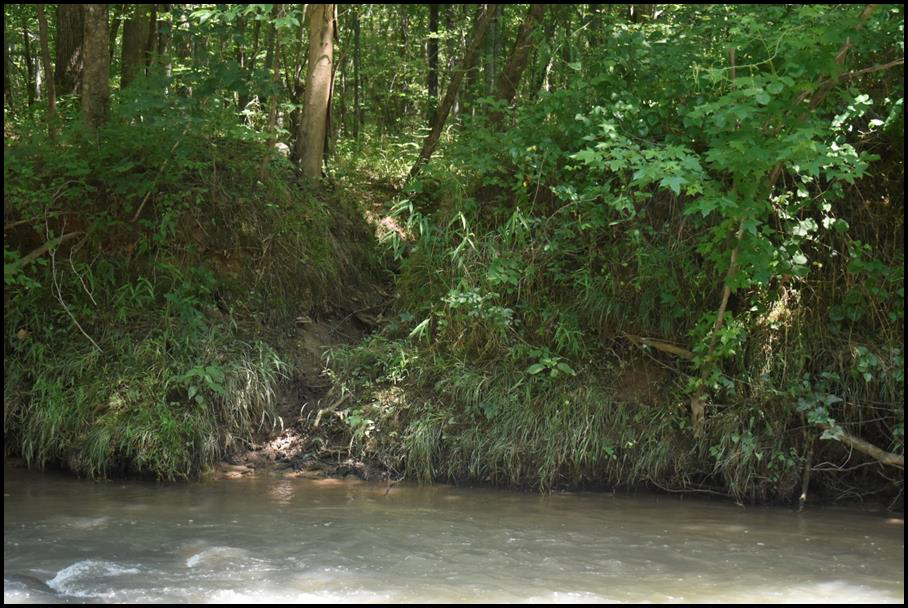
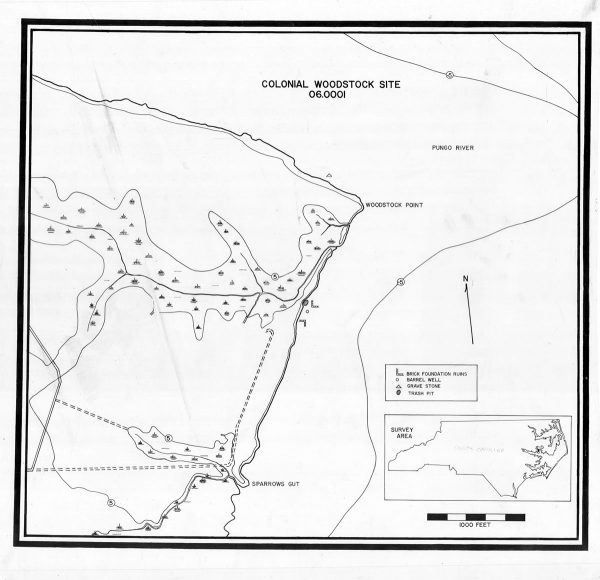
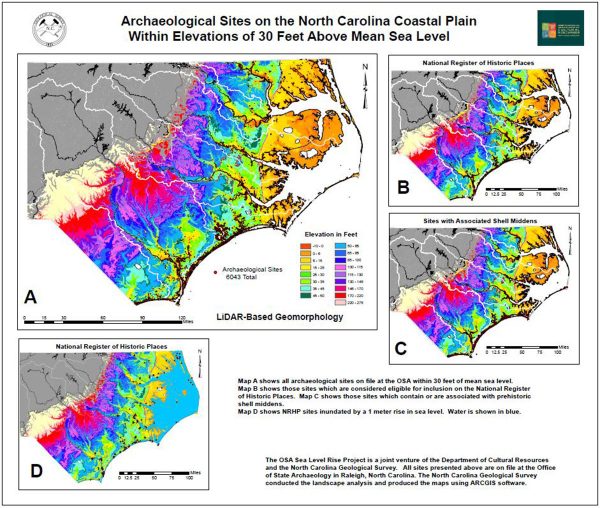
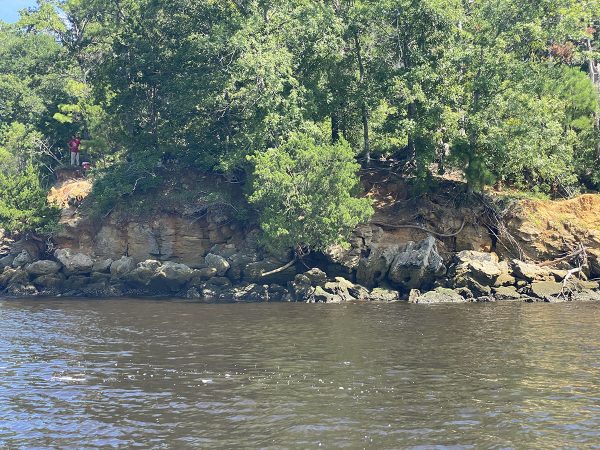
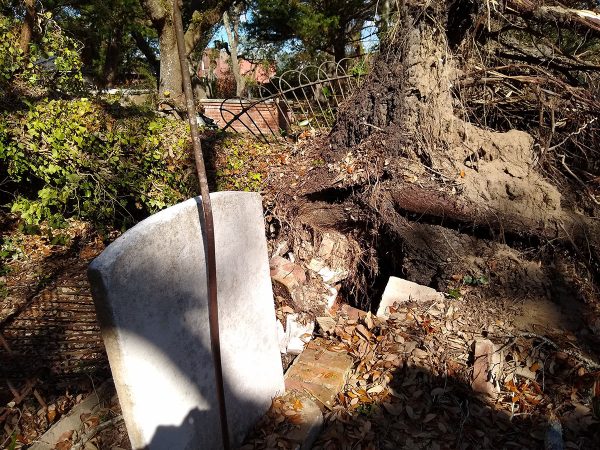
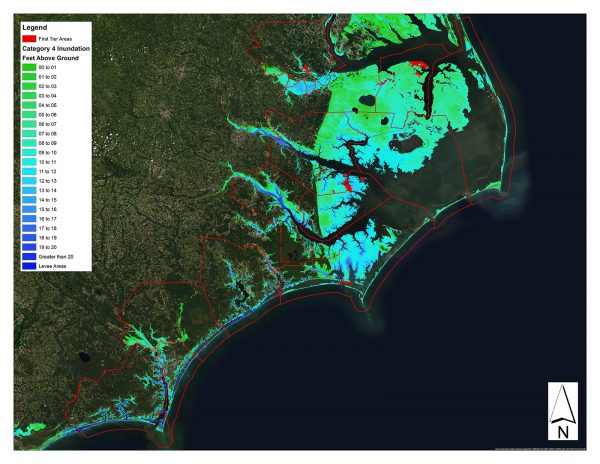
Pingback: WAC May 2012 eNewsletter – Volume 40 – World Archaeology Congress